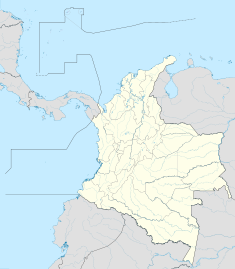- Miel I Dam
-
Miel I Dam Location of Miel I Dam Official name Presa Patángoras Country Colombia Location Norcasia Coordinates 05°33′38″N 74°53′12″W / 5.56056°N 74.88667°WCoordinates: 05°33′38″N 74°53′12″W / 5.56056°N 74.88667°W Status Operational Construction began 1997 Opening date 2002 Owner(s) ISAGEN Dam and spillways Type of dam Gravity, roller-compacted concrete Height 188 m (617 ft) Height (thalweg) 340 m (1,115 ft) Volume 1,750,000 m3 (2,288,914 cu yd) Crest elevation 454 m (1,490 ft) Impounds La Miel River Type of spillway Uncontrolled overflow Spillway capacity 3,600 m3/s (127,133 cu ft/s) Reservoir Creates Amani Reservoir Capacity 571,000,000 m3 (462,917 acre·ft) Catchment area 770 km2 (297 sq mi)[1] Surface area 1,220 ha (3,015 acres) Normal elevation 445.5 m (1,462 ft) Power station Commission date 2002 Turbines 3 x 132 MW Francis-type Installed capacity 396 MW Annual generation 1,146 GWh The Miel I Dam, officially known as the Patángoras Dam, is a gravity dam on La Miel River just south of Norcasia in Caldas Department, Colombia. The dam was constructed between 1997 and 2002 for the primary purpose of hydroelectric power generation. At the time of its completion, the dam was the tallest roller-compacted concrete (RCC) dam in the world but was surpassed by the Longtan Dam in 2009.
Contents
Background
Designs for the dam were drawn up in 1992 and 1993 before bidding was carried out in December of that same year. An RCC design was chosen to reduce costs and risks associated with excavating a larger foundation for an arch dam. Funding was acquired for the project by December 1997 when construction began. The power plant was operational in 2002 and the project was completed in 59 months, seven months ahead of time.[2] The dam is part of the Miel I Hydroelectric Station and is officially called the Patángoras Dam but is commonly referred to as the Miel I Dam.[3]
Design
The dam is a 340 m (1,115 ft) long RCC gravity-type containing 1,750,000 m3 (2,288,914 cu yd) of concrete. It is located just east of the confluence of the Moro and La Miel Rivers.[3] At the center of the structure and running down its downstream dace, is an uncontrolled overflow spillway with a nominal capacity of 1,720 m3/s (60,741 cu ft/s) and maximum discharge capacity of 3,600 m3/s (127,133 cu ft/s) (at the dam's crest elevation of 454 m (1,490 ft)).[2] A discharge tunnel is also located at the base of the dam, on its right bank, which has a capacity of 250 m3/s (8,829 cu ft/s). The reservoir created by the dam, Amani reservoir, has a storage capacity of 571,000,000 m3 (462,917 acre·ft) and surface area of 1,220 ha (3,015 acres). The reservoir's normal elevation above sea level is 445.5 m (1,462 ft). On the left bank of the reservoir near the dam is the intake for the power plant which is controlled by two floodgates. Water conducted to the power house is transferred into a 6.5 m (21 ft) diameter tunnel which splits into three 3.35 m (11 ft) diameter penstocks before reaching each turbine. The power house is located underground and contains a machine, transformer and surge tank chambers. Power is produced by three 132 MW Francis turbine generators for a total installed capacity of 396 MW.[3]
See also
- List of power stations in Colombia
References
- ^ "La Miel River Watershed". Condesan. http://www.condesan.org/andean/index.shtml?apc=F~b~a~i~EN~1-&x=6955&als%5Btab%5D=inf&vid=631. Retrieved 5 July 2011.
- ^ a b Eduardo Castell, Humberto Santana (26 January 2004). "RCC Record Breaker". International Water Power & Dam Construction. http://wp.abasoft.co.uk/story.asp?storyCode=2019746. Retrieved 5 July 2011.
- ^ a b c "Miel I Hydroelectric Power Plant". ISAGEN. http://www.isagen.com.co/metaInst_Eng.jsp?rsc=infoIn_Eng_centralMiel1. Retrieved 5 July 2011.
Categories:- Dams in Colombia
- Hydroelectric power stations in Colombia
- Gravity dams
Wikimedia Foundation. 2010.

